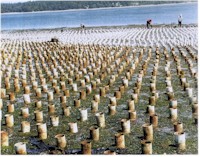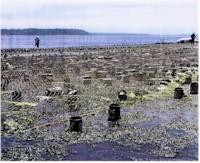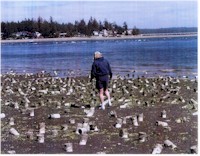| "DEVELOPING" TIDELANDS WITH
PLASTIC, NETTING, AND REBAR
"Substantial
Development" of aquaculture in the tidelands along shorelines is being permitted in
the State of Washington.
Commercial ventures are taking place in
Pacific coastal areas that support abundant
wildlife and aquatic life, along rural residential shorelines, and along
stretches of beach property that have been enjoyed for beachcombing,
recreation and for the beauty and health that nature provides.
|

Tubes in the Tidelands
Click to
enlarge photo |
Geoduck Aquaculture
(also known as Gweduck, pronounced "gooeyduck," are giant edible
burrowing clams).
Geoduck aquaculture farming requires PVC
pipes (12 " in length and 3-4 " in diameter) to be partially stuck into
the tideland clay spaced
1 foot apart, leaving about 4"
jutting out above ground. The pipes are then covered with
net caps. Within a 2.46 acre area, there could be 107,158 PVC
pipes (each a foot apart) stretched out along the shoreline about 50
feet from shore all the way out to the low mean tide line. About a
year or so later, the PVC pipes are pulled up (if they are still
there) and the geoducks left to continue growing for another
3 years. After several years have gone by,
powerful pressurized waterguns are used to blast away 3 foot deep pits
in the acres of sandy mud so the geoducks can be pulled out and shipped off
for marketing. |
|

Tidelands of Plastic,
Netting, and Rebar
Click to enlarge
photo
|
Aquaculture farming of manila clams is also being conducted on beaches
on a rotational basis. Clams are planted directly into the beach
and then the whole area covered over with large netting held by steel
rebar for about 3 years while the clams grow. |
|

Trashing the Tidelands
Click
to enlarge photo |
Netting, tubes, rebar, and broken pieces of these components
have been dislodged by wind, high tides, and waves and
migrated to beaches and out into the deeper waters where
they could be ingested by marine species and seabirds. We
should say "will be ingested," because debris can move
around for years in water that isn't stationary.
Floating netting is a certain deathtrap for any creature
unfortunate enough to become entangled in it. Walking on
these once pristine beaches is no longer a pleasure, and
could very well be a hazard. Netting and dislodged tubes could also cause harm to
boaters, windsurfers, fishermen, skiers and swimmers. |
|
|
|
Residents in these areas are alarmed at
this devastation of natural habitat, and wondering why this is being
allowed. More and more of this type of aquaculture is spreading in
the Puget Sound area, and less and less questions are being answered for
concerned residents.
Visit the
Protect Zangle Cove
website to find more information, contacts, photos, and
important links. Various groups are forming and asking for
your help and involvement.
|


